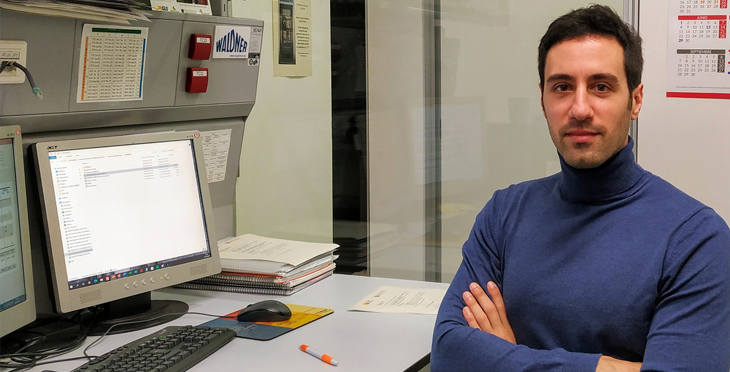Diagnostic use and prognostic impact of genetic variants in systemic mastocytosis

Javier Ignacio Muñoz González
Centro de Investigación del Cáncer (CIC-IBMCC)
Systemic mastocytosis (SM) comprises an heterogeneous group of clonal disorders affecting hematopoietic stem cells (HSC) characterized by the accumulation of mast cells in several organs and tissues (i.e. the skin, bone marrow, liver, among others)1. From a clinical and prognostic point of view, SM displays a very broad behavior in terms of clinical onset, tumor burden and prognosis1. Moreover, in the 2016 WHO classification2 5 different categories of SM were described including from indolent to more aggressive subtypes. However, the prognosis of individual patients within each WHO SM subvariant shows substantial heterogeneity and a high degree of prognostic overlap may also exist across the advanced SM subtypes (AdvSM; aggressive SM, SM with associated haematological neoplasm and mast cell leukaemia)3-5. Thus, while a fraction of non-advanced SM (NonAdvSM; indolent SM and smouldering SM) patients will progress to more advanced forms of SM and eventually die6,7, some patients with AdvSM may demonstrate stable disease for years despite their generally worse survival8-10.
The KIT D816V somatic mutation is present in the majority of adult SM patients11,12, particularly among indolent SM and aggressive SM cases13. Thus, while this KIT mutation might represent the genetic driver of SM, on its own it cannot explain malignant transformation of the disease. However, multilineage involvement of bone marrow hematopoiesis by the KIT D816V mutation, found in around one third of ISM cases and the great majority of advanced forms of SM7,13,14, particularly when this mutation is already present in an early pluripotent precursor cell involving also mesenchymal stem cells (MSC), significantly enhances the probability of progression from ISM to advanced forms of SM15. Recent studies on murine models have shown that D816V KIT mutation is able to mimic the clinical behavior of NonAdvSM but not that of AdvSM16,17. Altogether, these findings suggest that either acquisition of additional genetic/epigenetic alterations affecting the tumor cells and other hematopoietic cells along with the KIT mutation, and/or the existence of a specific genetic background, might be required for progression of NonAdvSM to more severe forms of the disease18-20. Recently, few studies based on limited gene panels have analyzed the presence of additional mutations mainly in AdvSM18,19,21. However, the variables that might contribute to identify those NonAdvSM patients at risk of disease progression and/or death have not been clearly established. These studies have shown a very similar pattern of mutated genes (SRSF2, ASXL1, RUNX1, NRAS, DNMT3A and TET2, among others) in AdvSM patients than that of other myeloid neoplasms22-24. In fact, the presence of mutations within SRSF2, ASXL1, RUNX1 and/or NRAS genes has shown to be an independent prognostic factor for overall survival in AdvSM25,26. This finding has promoted the development of different prognostic scoring models from the different reference centers in Europe and the USA. In fact, 5 different scoring models, that analyzed different parameters, have been proposed in the last two years (2018-2019), which has brought hesitation regarding which scoring model should be used8,9,27.
With all the aforementioned, we established three specific aims:
1.- To determine the frequency, type and prognostic impact of somatic and germline mutations affecting genes other than KIT in patients with NonAdvSM and AdvSM and to establish the clonal hierarchy of the different somatic mutations.
2.- To establish the frequency and prognostic impact of somatic mutations affecting genes other than KIT in NonAdvSM and to determine the best combination of clinical, laboratory and molecular parameters to predict progression from NonAdvSM to AdvSM
3.- To establish and to validate a new scoring model based on simultaneous evaluation of all clinical, laboratory and molecular variables that have been previously reported to have independent prognostic value for progression-free survival and overall survival and; subsequently, to compare the new scoring system, with other recently proposed risk stratification models for SM.
- Valent P, Horny HP, Escribano L, et al. Diagnostic criteria and classification of mastocytosis: a consensus proposal. Leuk Res. 2001;25(7):603-625.
- Horny HP, Akin C, Arber D, et al. Mastocytosis. In: Swerdlow SH, Campo E, Harris NL, et al. World Health Organization (WHO) Classification of Tumours. Pathology & Genetics. Tumours of Haematopoietic and Lymphoid Tissues. Lyon: IARC; 2016.
- Valent P, Akin C, Hartmann K, et al. Advances in the Classification and Treatment of Mastocytosis: Current Status and Outlook toward the Future. Cancer Res. 2017;77(6):1261-1270.
- Jawhar M, Schwaab J, Meggendorfer M, et al. The clinical and molecular diversity of mast cell leukemia with or without associated hematologic neoplasm. Haematologica. 2017;102(6):1035-1043.
- Sperr WR, Horny HP, Lechner K, Valent P. Clinical and biologic diversity of leukemias occurring in patients with mastocytosis. Leuk Lymphoma. 2000;37(5-6):473-486.
- Munoz-Gonzalez JI, Alvarez-Twose I, Jara-Acevedo M, et al. Frequency and prognostic impact of KIT and other genetic variants in indolent systemic mastocytosis. Blood. 2019;134(5):456-468.
- Escribano L, Alvarez-Twose I, Sanchez-Munoz L, et al. Prognosis in adult indolent systemic mastocytosis: a long-term study of the Spanish Network on Mastocytosis in a series of 145 patients. J Allergy Clin Immunol. 2009;124(3):514-521.
- Sperr WR, Kundi M, Alvarez-Twose I, et al. International prognostic scoring system for mastocytosis (IPSM): a retrospective cohort study. Lancet Haematol. 2019;6(12):e638-e649.
- Jawhar M, Schwaab J, Alvarez-Twose I, et al. MARS: Mutation-Adjusted Risk Score for Advanced Systemic Mastocytosis. J Clin Oncol. 2019;37(31):2846-2856.
- Reiter A, George TI, Gotlib J. New developments in diagnosis, prognostication, and treatment of advanced systemic mastocytosis. Blood. 2020;135(16):1365-1376.
- Longley BJ, Jr., Metcalfe DD, Tharp M, et al. Activating and dominant inactivating c-KIT catalytic domain mutations in distinct clinical forms of human mastocytosis. Proc Natl Acad Sci U S A. 1999;96(4):1609-1614.
- Orfao A, Garcia-Montero AC, Sanchez L, Escribano L, Rema. Recent advances in the understanding of mastocytosis: the role of KIT mutations. Br J Haematol. 2007;138(1):12-30.
- Garcia-Montero AC, Jara-Acevedo M, Teodosio C, et al. KIT mutation in mast cells and other bone marrow hematopoietic cell lineages in systemic mast cell disorders: a prospective study of the Spanish Network on Mastocytosis (REMA) in a series of 113 patients. Blood. 2006;108(7):2366-2372.
- Sotlar K, Colak S, Bache A, et al. Variable presence of KITD816V in clonal haematological non-mast cell lineage diseases associated with systemic mastocytosis (SM-AHNMD). J Pathol. 2010;220(5):586-595.
- Garcia-Montero AC, Jara-Acevedo M, Alvarez-Twose I, et al. KIT D816V-mutated bone marrow mesenchymal stem cells in indolent systemic mastocytosis are associated with disease progression. Blood. 2016;127(6):761-768.
- Soucie E, Hanssens K, Mercher T, et al. In aggressive forms of mastocytosis, TET2 loss cooperates with c-KITD816V to transform mast cells. Blood. 2012;120(24):4846-4849.
- De Vita S, Schneider RK, Garcia M, et al. Loss of Function of TET2 Cooperates with Constitutively Active KIT in Murine and Human Models of Mastocytosis. PLoS One. 2014;9(5):96209.
- Schwaab J, Schnittger S, Sotlar K, et al. Comprehensive mutational profiling in advanced systemic mastocytosis. Blood. 2013;122(14):2460-2466.
- Bibi S, Langenfeld F, Jeanningros S, et al. Molecular defects in mastocytosis: KIT and beyond KIT. Immunol Allergy Clin North Am. 2014;34(2):239-262.
- Wilson TM, Maric I, Simakova O, et al. Clonal analysis of NRAS activating mutations in KIT-D816V systemic mastocytosis. Haematologica. 2011;96(3):459-463.
- Traina F, Visconte V, Jankowska AM, et al. Single nucleotide polymorphism array lesions, TET2, DNMT3A, ASXL1 and CBL mutations are present in systemic mastocytosis. PLoS One. 2012;7(8):e43090.
- Bejar R, Stevenson K, Abdel-Wahab O, et al. Clinical Effect of Point Mutations in Myelodysplastic Syndromes. N Engl J Med. 2011;364(26):2496-2506.
- Jankowska AM, Makishima H, Tiu RV, et al. Mutational spectrum analysis of chronic myelomonocytic leukemia includes genes associated with epigenetic regulation: UTX, EZH2, and DNMT3A. Blood. 2011;118(14):3932-3941.
- Kar SA, Jankowska A, Makishima H, et al. Spliceosomal gene mutations are frequent events in the diverse mutational spectrum of chronic myelomonocytic leukemia but largely absent in juvenile myelomonocytic leukemia. Haematologica. 2013;98(1):107-113.
- Jawhar M, Schwaab J, Schnittger S, et al. Additional mutations in SRSF2, ASXL1 and/or RUNX1 identify a high-risk group of patients with KIT D816V(+) advanced systemic mastocytosis. Leukemia. 2016;30(1):136-143.
- Pardanani A, Lasho T, Elala Y, et al. Next-generation sequencing in systemic mastocytosis: Derivation of a mutation-augmented clinical prognostic model for survival. Am J Hematol. 2016;91(9):888-893.
- Pardanani A, Shah S, Mannelli F, et al. Mayo alliance prognostic system for mastocytosis: clinical and hybrid clinical-molecular models. Blood Advances. 2018;2(21):2964-2972.

